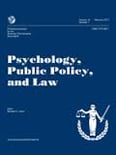 The combination of two risk measures, the Ontario Domestic Assault Risk Assessment (ODARA) and the Spousal Assault Risk Assessment (SARA), has been effective in assessing violence risk and predicting recidivism in intimate partner violence offenders. This is the bottom line of a recently published article in Law and Human Behavior. Below is a summary of the research and findings as well as a translation of this research into practice.
The combination of two risk measures, the Ontario Domestic Assault Risk Assessment (ODARA) and the Spousal Assault Risk Assessment (SARA), has been effective in assessing violence risk and predicting recidivism in intimate partner violence offenders. This is the bottom line of a recently published article in Law and Human Behavior. Below is a summary of the research and findings as well as a translation of this research into practice.

Featured Article | Law and Human Behavior | 2017, Vol. 41, No. 5, 440-453
Incremental Prediction of Intimate Partner Violence: An Examination of Three Risk Measures
Authors
Mark E. Olver, Department of Psychology, University of Saskatchewan
Sandy Jung, Department of Psychology, MacEwan University
Abstract
Improvements in the risk prediction of domestic violence against intimate partners have the potential to inform policing practices in the prevention of further victimization. The present study examined the incremental predictive validity of 3 measures of risk for intimate partner violence (IPV)—Spousal Assault Risk Assessment (SARA), Ontario Domestic Assault Risk Assessment (ODARA), and the Family Violence Investigative Report (FVIR)—for IPV, general violence, and general recidivism outcomes. The sample featured 289 men and women who were reported to police for IPV and followed up approximately 3 years post release. Archival ratings of the 3 measures demonstrated that SARA scores showed incremental validity for IPV recidivism, ODARA scores incrementally predicted general violence, and both tools incrementally predicted general recidivism. The FVIR did not incrementally predict any outcomes. Fine grained analyses demonstrated that the Psychosocial Adjustment domain of the SARA contributed most uniquely to the prediction of IPV. Survival analysis supported the use of the SARA and ODARA in tandem for appraising risk for IPV or general criminal recidivism. Calibration analyses using logistic regression modeling also demonstrated 3-year recidivism estimates for SARA and ODARA scores. Implications for the use of multiple tools in clinical practice are discussed, particularly for combining the SARA and ODARA measures to augment IPV risk assessment and management.
Keywords
Intimate partner violence, SARA, ODARA, risk assessment, recidivism
Summary of the Research
“Although existing research has demonstrated that the SARA and the ODARA perform comparably in predicting IPV [Intimate Partner Violence] recidivism, these tools were developed for related but slightly different purposes. The ODARA was originally developed as an easy-to-use actuarial tool to assess risk of spousal assault…However, more than three quarters of the items are static in nature and the ODARA may thus be limited when informing intervention services or assessing changes in risk; that is, it would do little to inform dynamic areas to target for IPV intervention, and the tool is not structured to assess possible reductions in risk from treatment or other change agents. In contrast…nearly half of the items on the SARA are ostensibly dynamic variables that are potentially changeable and which have conceptual overlap with the Central Eight (e.g., recent employment instability, recent relationship instability, substance abuse concerns, assault supportive attitudes)” (p. 442).
“[Q]uantitative reviews of the IPV risk literature reveals that most, if not all, studies have heretofore examined the instruments in isolation, as IPV ‘risk instrument silos’; it has been our observation that efforts to examine the integration of any of these tools has been noticeably absent from the literature” (p. 442).
“Data was coded from a random selection of 300 cases of IPV that were reported to a local police service over a 4-year period from 2010 to 2013. Eligibility criteria included IPV cases that involved a perpetrator and a complainant who were, at one time, intimate partners (e.g., break-up prior to the occurrence, currently partners), the incident led to formal charges for direct violence or the threat of direct violence to an intimate partner, and it was clear who was the perpetrator (i.e., cases were excluded in scenarios where both parties were assaultive in the incident and both were charged or not charged)” (p.442).
“Items from the three measures described above [the ODARA, the SARA, the FVIR] and the recidivism outcomes were coded from extensive review of police file documentation. As the present study is retrospective in nature, these instruments were coded prior to obtaining recidivism data and thus blind to outcome to prevent criterion contamination” (p. 443).
“The sample was followed up an average of 3.30 years (SD = 1.16) in the community, during which time, 9.3% (n = 27) were convicted for a new intimate partner violent offense, 15.6% (n = 45) were convicted for any new violent offense, and 47.4 (n = 137) were convicted for any new offense” (p. 444).
“In the first block, ODARA scores were significantly associated with increased IPV, any violent, and general recidivism, with each one-point increase in ODARA score being associated with a 28% to 39% increase in the hazard of one of those recidivism outcomes. SARA scores were incrementally predictive of IPV recidivism at p = .063 (Model 1) after controlling for the ODARA, and significantly incrementally predicted general recidivism (Model 5); however, SARA scores did not incrementally predict general violent recidivism above and beyond the ODARA (Model 3). FVIR scores did not incrementally predict any of the three recidivism outcomes controlling for the ODARA (Models 2, 4, and 6)” (p. 445).
“First, the SARA seemed to outperform the ODARA and the FVIR in the prediction of IPV recidivism; it was the only measure to come close to the incremental prediction of recidivism when controlling for the ODARA, but not vice versa. By contrast, if there was a winner in the prediction of general violence, it would be the ODARA in this sample, as only it uniquely incrementally predicted this outcome irrespective of the instrument controlled; however, neither the SARA nor FVIR uniquely predicted general violence when controlling for the ODARA…finally, both the SARA and ODARA demonstrated incremental predictive validity in the prediction of general recidivism over time; as such, there was unique variance within each instrument that was informative in the prediction of this broad outcome” (p. 451).
Translating Research into Practice
“The implications are that use of a single instrument scoring in the medium range could result in an over estimate or under estimate of risk if a second instrument generated a different estimate. The results would seem to provide at least partial support for the incremental predictive validity of the tools at the categorical risk level for these two recidivism outcomes” (p. 451).
“The FVIR struggled the most of the three instruments and did not have incremental value in the prediction of any of the three recidivism outcomes after controlling for two well-established IPV risk assessment measures” (p. 451).
“These findings would suggest that there is value added in using more than one tool in IPV risk assessment, such as the SARA and ODARA…from a purely empirical standpoint, on their own they each predict their targeted recidivism outcomes, and when taken together, they seem to have different strengths in prediction tasks, at least in the present sample…the tools in tandem yield a more comprehensive volume of information to inform risk assessment and management” (p. 452).
Other Interesting Tidbits for Researchers and Clinicians
“Follow-up analyses demonstrated that the SARA Criminal History and Psychosocial Adjustment subscales contained most of the risk variance in the prediction of the three outcomes. The results of Cox regression analyses utilizing the scale components demonstrated that it was the Psychosocial Adjustment subscale that drove the SARA’s incremental prediction of IPV recidivism, while this and the Criminal History subscale performed well relative to the ODARA in the prediction of any recidivism” (p. 451).
“The results suggest that pairing the latter two measures [SARA and ODARA] in IPV assessment may be fruitful and that tools may complement one another; while the tools independently or in combination can estimate risk for IPV, any violence, and general recidivism, the SARA has domains that may be targeted for intervention and risk management” (p. 452).
“[M]ost measures are examined by networks of people linked to their development, and thus the present body of work provides an independent examination of important psychometric properties of the ODARA and the SARA. The inclusion of female perpetrators also builds on existing IPV risk assessment research with female perpetrators…further research may profit from examinations of larger numbers of female perpetrators to replicate and extend these findings” (p. 452).
“The dynamic predictive validity of the SARA, and more specifically, its capacity to measure changes in IPV risk, is currently an unknown property; further research on a treated or supervised sample of IPV men and women may be fruitful in evaluating its capacity to assess dynamic IPV risk” (p. 452).
Join the Discussion
As always, please join the discussion below if you have thoughts or comments to add!






















